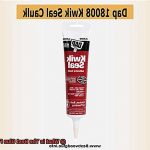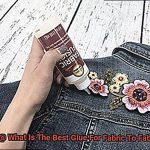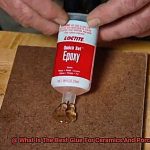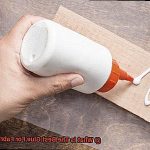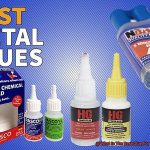Do you know the frustration of trying to bond aluminium and wood together, only to end up with a weak, unreliable connection that falls apart at the slightest touch? Fear not, my friend. There are plenty of glue options available to help you achieve a strong and durable bond between these two materials.
In this blog post, we will explore the best glue options for aluminium to wood. We’ll cover everything you need to know to ensure your project is a success. From the types of glue that work best, to the techniques for applying them effectively, we’ve got you covered.
We’ll delve into all kinds of adhesive options – from epoxy adhesives to cyanoacrylate glues. Whether you’re working on a DIY woodworking project or an industrial metal fabrication task, we’ve got the information you need to make sure your aluminium and wood surfaces stay firmly attached.
So get ready to unleash your inner DIY guru and discover the most effective ways to bond aluminium and wood together. Stay tuned as we guide you through all the pros and cons of each option – let’s get started.
Advantages and Disadvantages of Epoxy
Contents
- 1 Advantages and Disadvantages of Epoxy
- 2 Benefits of Using Polyurethane Glue
- 3 Pros and Cons of Superglue
- 4 Hybrid Adhesives: Combining the Best of Both Worlds
- 5 Factors to Consider When Choosing an Adhesive for Aluminium to Wood Bonding
- 6 Pre-Test Before Starting the Project
- 7 Tips for Applying Glue on Aluminium and Wood Surfaces
- 8 Common Mistakes to Avoid When Bonding Aluminium and Wood with Glue
- 9 Conclusion
Look no further than epoxy. This two-part adhesive is a popular choice for heavy-duty applications due to its high strength, water resistance and ability to fill gaps. However, before you dive into using epoxy, it’s important to weigh both the advantages and disadvantages.
Advantages:
- High strength: Epoxy creates a strong, permanent bond that can withstand heavy loads, making it ideal for industrial and construction projects.
- Water-resistant: Epoxy is highly resistant to water and can be used for outdoor applications where exposure to moisture is a concern.
- Fills gaps: Epoxy has the unique ability to fill gaps and voids in the joint, providing a tight seal that prevents moisture from seeping in.
Disadvantages:
- Long curing time: One of the main drawbacks of using epoxy is its relatively long curing time. Depending on the specific product used, it can take several hours or even days to fully cure. This may be inconvenient for those who need a quick fix.
- Potential yellowing over time: Epoxy is not UV resistant and may yellow over time when exposed to sunlight. This can affect the appearance of the bonded materials.
- Difficult to remove: Once cured, epoxy can be difficult to remove. This makes any mistakes made during application difficult to rectify, which can lead to additional time and cost.
- Expensive: Epoxy can be more expensive compared to other types of adhesives. However, its durability and strength make it worth considering for certain projects.
Benefits of Using Polyurethane Glue
As a professional in the field of adhesives, I can confidently say that polyurethane glue is a top choice for bonding aluminium and wood. This versatile adhesive offers numerous benefits that make it ideal for various applications.
One of the most significant advantages of using polyurethane glue is its strong bonding ability. This adhesive can create a permanent and durable bond between aluminium and wood, making it an excellent choice for heavy-duty projects. It penetrates deep into the pores of the material, resulting in an incredibly tight bond that can withstand heavy loads and stress.
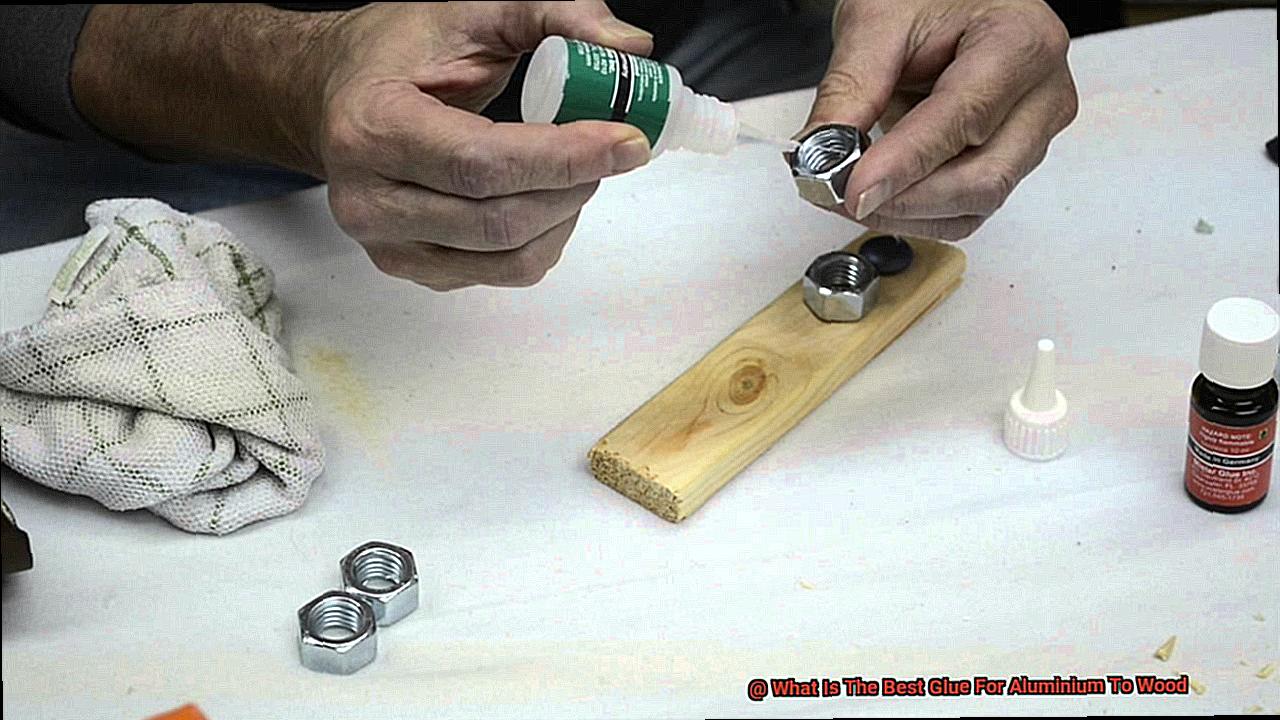
In addition to its strong bonding ability, polyurethane glue is also water-resistant. If you’re working on outdoor projects or items that are likely to be exposed to moisture, this adhesive is an excellent option. Unlike other adhesives that break down when exposed to water, polyurethane glue ensures that the bond remains strong and intact even in wet conditions.
Another benefit of this adhesive is its ability to expand as it cures. This expansion property helps to fill any gaps or irregularities in the surfaces being bonded, creating a more secure bond with no weak spots. This feature makes polyurethane glue ideal for bonding materials with uneven surfaces or hard-to-reach areas.
Polyurethane glue also has excellent temperature resistance, making it suitable for use in both hot and cold environments. It can withstand temperatures ranging from -40°F to 200°F, ensuring that the bond remains stable even in extreme conditions.
Lastly, one of the best things about polyurethane glue is how easy it is to use. You don’t need any special equipment or surface preparation, making it perfect for DIY projects or quick repairs. Just apply the adhesive to your chosen surfaces and let it cure – it’s that simple.
Pros and Cons of Superglue
Look no further than superglue. However, before you reach for this miracle adhesive, it’s important to weigh the pros and cons to ensure it’s the best option for your specific project.
Let’s begin with the pros. Superglue has a lightning-fast drying time, making it an ideal option for quick fixes and repairs. Plus, its strong bond can withstand significant amounts of stress and force, making it a go-to adhesive for industrial or automotive applications.
However, there are some cons to keep in mind. One of the biggest drawbacks is that it cannot fill gaps between surfaces. Superglue works best on flat surfaces that fit together perfectly, so any gaps or imperfections may weaken the bond. Additionally, superglue can be challenging to remove once applied, making it less forgiving than other adhesives.
Another concern with superglue is its potential toxicity. The fumes released during the drying process can be harmful if inhaled, and it should not be ingested. It is crucial to use superglue in a well-ventilated area and wear protective gloves to prevent skin contact.
To summarize, while superglue can be a strong and convenient adhesive for bonding aluminum to wood, it may not be suitable for all projects. Here’s a list of pros and cons to consider:
Pros:
- Fast-drying time
- Strong bond
- Ideal for industrial or automotive applications
Cons:
- Cannot fill gaps between surfaces
- Challenging to remove once applied
- Potential toxicity
Hybrid Adhesives: Combining the Best of Both Worlds
Look no further than hybrid adhesives, the revolutionary adhesive that combines the best of both worlds. As an expert in the field, I can attest to the exceptional properties of hybrid adhesives.
Hybrid adhesives are a game-changer. They take the best properties of different types of adhesives and blend them into one, creating a product that is stronger and more versatile than any one adhesive alone. When it comes to bonding aluminium to wood, hybrid adhesives are a clear winner over traditional adhesives.
One of the most significant advantages of hybrid adhesives is their ability to bond well to both materials at the same time. Unlike traditional adhesives, hybrid adhesives are specifically designed to excel in this area. Whether you’re a DIY enthusiast or a professional, you can trust that your aluminium and wood will bond seamlessly with a hybrid adhesive.
But it doesn’t stop there – hybrid adhesives are also much stronger than traditional adhesives. By combining different types of adhesives into one product, you can take advantage of each adhesive’s unique properties. For example, super glue is known for its fast-drying and strong bonding properties, while epoxy is known for its toughness and resistance to impact. By blending these two types of adhesives into a hybrid adhesive, you get an adhesive that is fast-drying, strong, tough, and resistant to impact – all in one.
To summarize, hybrid adhesives offer several advantages over traditional adhesives when it comes to bonding aluminium to wood. Here’s a quick list:
- Hybrid adhesives bond well to both materials simultaneously.
- They are much stronger than traditional adhesives.
- They take advantage of the unique properties of each type of adhesive used in their formulation.
- They provide a seamless bond that is tough and resistant to impact.
Factors to Consider When Choosing an Adhesive for Aluminium to Wood Bonding
There are several factors to consider before selecting an adhesive that will provide long-lasting and durable results.
Firstly, take into account the type of wood being used. Different types of wood have varying properties such as porosity and density that can impact the adhesive’s performance. Pine, for example, is more porous than oak, and therefore may require a different adhesive.
Secondly, consider the type of aluminium being used. Sheet metal, extruded or cast aluminium all have distinct properties that must be accounted for when selecting an adhesive. It’s essential to choose an adhesive that is compatible with the specific type of aluminium used.
Thirdly, environmental conditions must be taken into account. If the bond will be exposed to high temperatures, moisture or chemicals, then a special adhesive that can withstand these conditions should be used. Choosing an adhesive that is not resistant to these environmental factors may lead to a weak bond over time.
Fourthly, determine the strength of the bond required. Some adhesives provide a stronger bond than others, so it’s essential to select an adhesive that meets your specific requirements. For example, if you need a load-bearing joint, then an adhesive with high shear strength should be used.
Lastly, consider the ease of application and curing time of the adhesive. Some adhesives may require special preparation or application techniques, while others may cure quickly or slowly depending on the user’s requirements. The ease of use and curing time of the adhesive can impact the timeline and success of your project.
Pre-Test Before Starting the Project
Starting any project that involves gluing aluminium to wood can be a tricky task, and you may be wondering where to start. Well, the answer is simple: perform a pre-test. This important step will save you time, money, and headaches in the long run by helping you determine which type of adhesive will work best for your specific project.
To initiate a pre-test, start by gathering a small sample of both the aluminium and wood materials you plan to use in your project. It’s always best to use scrap pieces to avoid damaging the actual pieces that will be used in the final product. Next, select several types of glue suitable for bonding aluminium and wood. Some common options include epoxy, cyanoacrylate (super glue), polyurethane, and silicone adhesives.
Once you’ve applied each adhesive according to the manufacturer’s instructions, allow them to dry completely before testing their strength. Apply force by pulling or twisting the sample pieces to see if they separate or break apart. The adhesive that holds up the best is the one you should use for your project.
It’s important to note that the results of a pre-test may vary depending on factors such as temperature, humidity, and materials being used. Therefore, it’s recommended to perform multiple tests under different conditions to ensure the strongest bond possible.
Taking the time to perform a pre-test before starting your project can prevent potential complications and ensure a strong and durable bond between your aluminium and wood materials. Not only will this save you time and money in the long run, but it will also give you peace of mind knowing that your finished product will be sturdy and reliable.
Tips for Applying Glue on Aluminium and Wood Surfaces
It can be a daunting task, but with the right tips and techniques, you can achieve a strong and durable bond. Here are five sub-sections to consider when applying glue on aluminium and wood surfaces:
Cleanliness is Key
Before applying any adhesive, ensure that the surfaces are clean and free from any dirt, grease, or other contaminants. Any debris on the surfaces can weaken the bond between the two materials. Use a degreaser or solvent to clean them thoroughly before applying any glue.
Choose the Right Adhesive
Choosing the right adhesive is crucial for achieving a strong and long-lasting bond between aluminium and wood surfaces. Epoxy adhesives are a popular choice for their strength and ability to withstand high loads and temperature variations. However, it is important to choose an epoxy adhesive that is suitable for both aluminium and wood surfaces.
Follow Manufacturer’s Instructions
It is essential to carefully follow the manufacturer’s instructions when applying the adhesive. This may include mixing the two-part adhesive thoroughly before application and applying it evenly onto both surfaces. Applying enough adhesive is also crucial to ensure adequate coverage and a strong bond.
Clamp or Apply Pressure
Clamping or applying pressure onto the bonded surfaces until the adhesive has fully cured can help ensure a strong and durable bond between the aluminium and wood surfaces. This will also prevent any air pockets from forming, which can weaken the bond.
Allow Adequate Curing Time
Finally, it is important to allow the adhesive to fully cure before subjecting the bonded surfaces to any stress or load. The curing time may take several hours or even days depending on the type of adhesive used and environmental conditions. Rushing this process may result in a weak bond.
Common Mistakes to Avoid When Bonding Aluminium and Wood with Glue
If you’re looking to bond aluminium and wood with glue, you’re in for a treat. The resulting bond can be incredibly strong and long-lasting. However, to achieve that ideal bond, you’ll need to be aware of some common mistakes that can sabotage your efforts.
Firstly, it’s important to prepare the surfaces properly. You wouldn’t paint a dirty or greasy wall, would you? The same applies here. Clean, dry surfaces are essential for a strong bond. Ensure that both surfaces are free from dirt, dust, or grease before applying any glue.
Secondly, choosing the right type of glue is vital. Not all adhesives work well on aluminium and wood. Using the wrong glue can result in a weak bond or even a complete failure of the joint. To avoid this, select an adhesive that’s specifically designed for bonding these two materials together.
Using too much or too little glue can also cause issues. If you use too much glue, there may be excess glue squeezing out of the joint, which can make it messy and weaken the bond. On the other hand, if you use too little adhesive, it may not provide enough coverage for a strong bond. It’s essential to follow the instructions on your chosen adhesive carefully.
The third mistake to avoid is not allowing enough time for the glue to dry and cure completely. It’s important to be patient during this process as rushing it can lead to a weak bond that may fail over time. Always follow the manufacturer’s instructions for drying and curing time and avoid disturbing the joint during this period.
Finally, not applying enough pressure during the bonding process can weaken the bond significantly. Using clamps or other tools can help apply pressure to the joint and ensure that it stays secure.
XQ6THQM0Qg0″ >
Conclusion
In summary, bonding aluminium to wood requires the right glue and techniques for a strong and durable bond. When it comes to heavy-duty applications, epoxy adhesives are a top choice due to their high strength, water resistance, and gap-filling ability. Polyurethane glue is also an excellent option with its strong bonding ability, water resistance, and expanding capabilities.
Superglue may be convenient for quick fixes but is not suitable for all projects due to its inability to fill gaps and potential toxicity. Hybrid adhesives combine the best properties of different types of adhesives into one product for a stronger and more versatile adhesive.
Selecting the right adhesive depends on factors such as wood and aluminium type, environmental conditions, required bond strength, ease of application, and curing time. A pre-test can help determine which adhesive will work best.
When applying glue on surfaces, cleanliness is crucial. Properly following manufacturer’s instructions and applying pressure or clamping helps ensure a strong bond. Adequate curing time is necessary for optimal results.
Avoid common mistakes such as improper surface preparation or using the wrong type or amount of glue.


